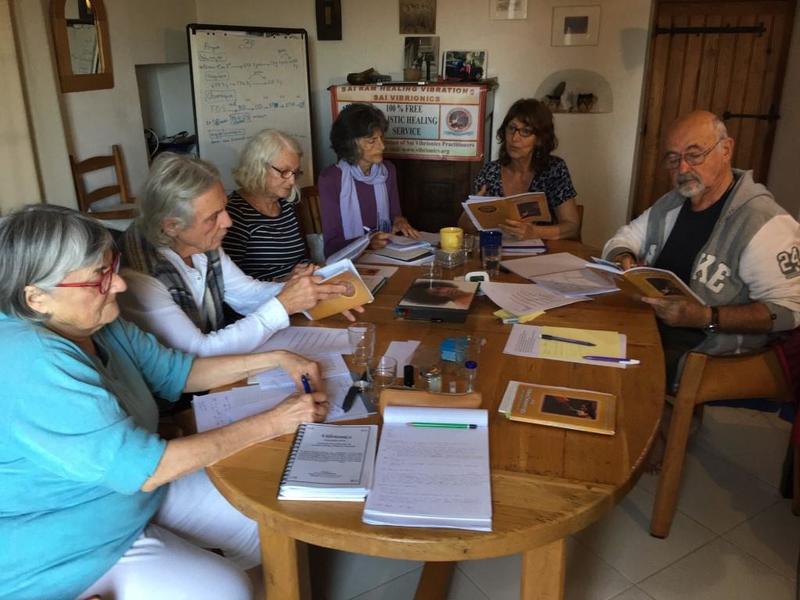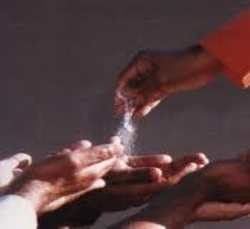In Addition
Vol 10 Issue 6
November/December 2019
1. Health Tips
Work towards a healthy thyroid!
“Moderate food is the best medicine… Do not rush to the hospital for every little upset. Too much drugging is also bad. Allow nature full scope to fight the disease and set you right. Adopt more and more the principles of naturopathy, and give up running around for doctors…” Sri Sathya Sai Baba1
1. Thyroid and its vital function
Thyroid is a small butterfly shaped endocrine gland in the middle of the lower neck, just below our Adam’s apple, on both sides of the lower part of the larynx and upper part of the trachea.2-4
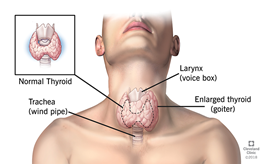 Role of thyroid: Its primary role in the endocrine system is to regulate body’s metabolism, that is, ability of the cells to break down food and convert it into energy. Almost all the metabolic parameters are influenced by this gland, like, appetite, energy level, heart-rate, body temperature and circulation, growth and bone development (especially in infants and children), muscle tone and suppleness, blood sugar level, bowel function, cholesterol level, fat, carbohydrate, and protein metabolism, body weight, blood calcium level, central nervous system, and reproductive system.2,3,5-9
Role of thyroid: Its primary role in the endocrine system is to regulate body’s metabolism, that is, ability of the cells to break down food and convert it into energy. Almost all the metabolic parameters are influenced by this gland, like, appetite, energy level, heart-rate, body temperature and circulation, growth and bone development (especially in infants and children), muscle tone and suppleness, blood sugar level, bowel function, cholesterol level, fat, carbohydrate, and protein metabolism, body weight, blood calcium level, central nervous system, and reproductive system.2,3,5-9
Functioning of thyroid: A properly functioning thyroid absorbs iodine from food, combines it with amino acid tyrosine in the body, and converts it into requisite T3 and T4 hormones (tri-iodothyronine and thyroxine respectively) to do its job. Unlike other endocrine glands, thyroid can store the hormones it produces.8,9,10
Regulated by pituitary and hypothalamus: The function of the thyroid is monitored and controlled by pituitary - the master gland, located in the centre of the skull below the brain. Pituitary adjusts the production of its hormone TSH (thyroid stimulating hormone) like a thermostat to support the thyroid. In turn, pituitary is stimulated by the thyroid releasing hormone (TRH) secreted by hypothalamus, a neuroendocrine gland located deep within the brain.3,5,6,8,10
Close to parathyroid glands: Physically attached to the thyroid at its posterior side, there are four tiny parathyroid glands. But, they have no functional relation with thyroid.11,12
2. Thyroid disorders
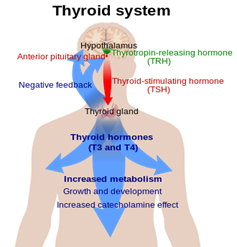 Broadly two issues may arise. Secretion of thyroid hormones (T3 and T4) may become insufficient due to underactive thyroid (hypothyroid) or excessive due to overactive thyroid (hyperthyroid). A simple blood test for thyroid profile will show the status. Symptoms and cause may vary from person to person.2
Broadly two issues may arise. Secretion of thyroid hormones (T3 and T4) may become insufficient due to underactive thyroid (hypothyroid) or excessive due to overactive thyroid (hyperthyroid). A simple blood test for thyroid profile will show the status. Symptoms and cause may vary from person to person.2
Thyroid function indicators: The level of TSH released by pituitary is usually an indicator of the normal functioning of thyroid. If thyroid becomes sluggish, pituitary will have to produce more TSH to stimulate thyroid to produce more hormones. So, if a blood test reveals a high TSH, it indicates hypothyroidism. Conversely, if thyroid is hyperactive, pituitary has to stop producing TSH so that the thyroid secretes less hormones; blood test would reveal a low TSH implying hyperthyroidism. These may get influenced by illnesses and medications. TSH test is not the only one used to diagnose thyroid disorder. Other tests like T3 and T4 are often used to determine whether there is need for thyroid treatment.13,14
Normal thyroid: Typical reference range of TSH for normal thyroid is: 0.4 to 4-5 mU/L (milliunits per litre of serum). This serves as a guide only as it may vary with age, gender, pregnancy, and also between laboratories.13,14
Symptoms of hypothyroidism: Symptoms would vary depending on the severity of hormone deficiency. Generally, body metabolism would slow down, unable to use energy at the pace it should.
- Infants may be unusually inactive and quiet, have poor appetite, and sleep for unduly long period.
- Children may show poor growth, delayed development of permanent teeth, delayed puberty, poor mental development.
- Symptoms for adults could be: sudden weight gain when not overeating, puffy face, fatigue, increased sensitivity to cold, dry skin, constipation, forgetfulness, mild depression, thinning hair, hair growth on face, hoarseness, increase in cholesterol level, muscle weakness, tenderness, and stiffness, and frequent and heavy menstrual periods in case of women.2,3,5-8,15,16,18
Causes of hypothyroidism:
- iodine deficiency which does not apply in some countries due to use of iodized salt.
- inflammation of thyroid gland (thyroiditis) which may also be due to an auto immune disorder (Hashimoto’s thyroiditis) where the body attacks the thyroid tissue which eventually stops producing hormones and dies; it is a painless disease and primarily affects middle aged women.
- a non-functioning thyroid gland in newborns, surgical removal of thyroid gland, or a pituitary disorder.
- exposure to excessive iodine due to intake of medicines for mental illnesses, eating disorders, or blood disorders.3,6,7,15,16
Symptoms of hyperthyroidism: They can mimic other health problems making it difficult to diagnose. Normally, the body would use energy faster than it should.
- Main symptoms are: thyroid gland looking bigger than it should due to swelling at the base of the neck, rapid heartbeat (tachycardia) - commonly more than 100 beats a minute, irregular heartbeat, pounding of heart, fast pulse, or tremor in fingers when we hold them out straight.
- Other symptoms may be unusually large appetite, sudden weight loss even with same or more intake of food, anxiety, nervousness and irritability, unusual sweating, increased sensitivity to heat, thinner skin, brittle hair, frequent bowel movements, feeling tired as if muscles are weak, poor concentration, osteoporosis, insomnia, eyes red or bulging, and infrequent or scant menstrual periods in case of women.
- Older adults are likely to have either no signs or subtle symptoms like increased heart rate, heat intolerance, and tendency to become tired during ordinary activities.2,3,5-8,15,17,18
Causes of hyperthyroidism:
- Grave’s disease, where the immune system attacks the thyroid to make more hormones than needed (more common among women below 40); it may sometimes lead to thyroid eye disease with varied symptoms in eyes;
- too much iodine in the body, due to excessive thyroid medication or supplements;
- toxic adenomas, goitres and nodules formed in the gland secrete hormones upsetting the chemical balance in the body; subacute thyroiditis where inflammation causes hormones to leak;
- malfunction of pituitary gland or cancerous growth in the thyroid gland.3,6,7,15,17
3. Prevent thyroid problem
If any of the symptoms persist, it is advisable to get the thyroid profile test done and take the necessary treatment without delay. Studies have shown that thyroid dysfunction can also manifest into other health disorders including salivary gland enlargement, breathing through mouth, burning mouth syndrome, caries, and dental osteoporosis.19,20 But one can and should work towards having a healthy thyroid through:18,21-30
- Regular exercise in fresh air as emphasized by scientific studies22, and yogasanas under the guidance of an expert. 18,21
- Foods rich in iodine and amino acids.Seasonal fresh fruits, especially colourful fruits like berries and grapes; green vegetables including kale, broccoli, and spinach; wholegrains, preferably soaked overnight or sprouted; nuts and seeds like cashew, almond, pumpkin seeds, and fenugreek; and yogurt. One should not eat too much of any single type of food, even if it is a recommended healthy choice.23-30
- Vitamin B-12 (for sources of vitamins-B, refer to Newsletter vol 9 issue 4, July-Aug 2018).27-29
- Selenium contained in brazil nut, sunflower seeds, mustard seeds, flax seeds, peanuts, barley, and brown rice.26-29
- Avoiding or minimising certain foods such as: gluten, salted products, stale or processed food, hidden fats and sugars like in cake, biscuit,and chocolate, and beverages like coffee.27-30
- Vibrionics remedies such as: CC6.1 Hyperthyroid, CC6.2 Hypothyroid, CC12.1 Adult tonic, CC12.4 Autoimmune diseases, CC15.4 Eating disorders, CC17.2 Cleansing if using 108CC box; NM72 Cleansing, NM86 Immunity, SR290 Endocrine integrity, SR308 Pituitary Gland, SR319 Thyroid Gland, SR498 Hypothalamus, SR517 Parathyroid, SR567 Hyperthyroidism, SR568 Hypothyroidism, SR572 Obesity when using the potentiser.
References and Links:
1. Food and Health:http://www.sssbpt.info/ssspeaks/volume14/sss14-31.pdf
2. What is Thyroid: https://www.webmd.com/a-to-z-guides/do-i-have-thyroid-problem
3. https://my.clevelandclinic.org/health/diseases/8541-thyroid-disease
4. Taber’s Cyclopaedic medical dictionary, edition 20, 2001, page 2187
5. https://www.endocrineweb.com/endocrinology/overview-thyroid
6. Metabolism: https://healthywa.wa.gov.au/Articles/S_T/The-thyroid-gland
7. http://www.vivo.colostate.edu/hbooks/pathphys/endocrine/thyroid/physio.html
8. https://www.crozerkeystone.org/conditions/endocrinology/Thyroid-Disorders/
9. Manual for Junior Vibrionics Practitioners, English 2007, chapter 7: Anatomy and Body Systems, page 37
10. Functioning of thyroid: https://www.endocrineweb.com/conditions/thyroid/how-your-thyroid-works
11. http://endocrinediseases.org/parathyroid/parathyroid_background.shtml
12. https://www.endocrineweb.com/endocrinology/overview-parathyroid
13. Thyroid function indicators: http://www.btf-thyroid.org/information/leaflets/34-thyroid-function-tests-guide
14. https://www.webmd.com/women/what-is-tsh-test#1
15. Thyroid disorders: https://www.webmd.com/women/guide/understanding-thyroid-problems-basics#1
16. https://www.mayoclinic.org/diseases-conditions/hypothyroidism/symptoms-causes/syc-20350284
17. https://www.mayoclinic.org/diseases-conditions/hyperthyroidism/symptoms-causes/syc-20373659
18. https://www.artofliving.org/in-en/yoga/health-and-wellness/cure-thyroid-with-yoga
19. Thyroid & BP: https://www.ncbi.nlm.nih.gov/pmc/articles/PMC3230087/
20. Thyroid and mouth: https://www.ncbi.nlm.nih.gov/pmc/articles/PMC3169868/
21. Work for a healthy thyroid: https://www.youtube.com/watch?v=3VZF-F6LRwU
22. Physical exercise important: http://www.amhsjournal.org/article.asp?issn=2321-4848;year=2015;volume=3;issue=2;spage=244;epage=246;aulast=Bansal
23. Balanced food: https://www.webmd.com/women/features/low-thyroid-alternative-therapy#1
24. Iodine rich food: https://ods.od.nih.gov/factsheets/Iodine-Consumer/
25. Amino acids rich food: https://www.medicalnewstoday.com/articles/324229.php
26. Selenium rich food: http://www.whfoods.com/genpage.php?tname=nutrient&dbid=95
27. Foods for thyroid: https://www.livestrong.com/article/497146-vegetarian-diet-for-hypothyroidism/
29. Plant based diet best: https://www.ncbi.nlm.nih.gov/pmc/articles/PMC3847753/
30. Foods to avoid: https://www.everydayhealth.com/hs/thyroid-pictures/foods-to-avoid/
2. AVP workshop & refresher seminar Zagreb, Croatia, 5-8 September 2019
Dr & Mrs Aggarwal felt greatly honoured to be invited to hold this seminar in Zagreb, exactly 20 years after their very first visit to Croatia when 68 practitioners were trained in the use of SRHVP in workshops held in Zagreb and Split. The credit for the success of the current event goes to the coordinator 03577 who worked extremely hard over a period of several months. In preparation for this seminar she individually contacted more than 100 existing practitioners (out of a total of 160 in Croatia) with a view to motivating them to renew their knowledge of vibrionics. She had the enormous task of inviting and examining applications, interviewing the candidates, and conducting correspondence course. Great care was taken of every small detail for the smooth running of the seminar in spite of some big challenges which the group had to face. This was a highly dedicated group of 15 participants, 6 new and 9 practising for some two decades; all the participants had studied well and updated their knowledge of theory and practice of vibrionics. They enjoyed learning in an atmosphere which was both very intense for studying and yet very informal and homely. This seminar was very important for the next step in the development of Sai vibrionics in Croatia. It resulted in new enthusiasm within all the participants for serving through vibrionics.
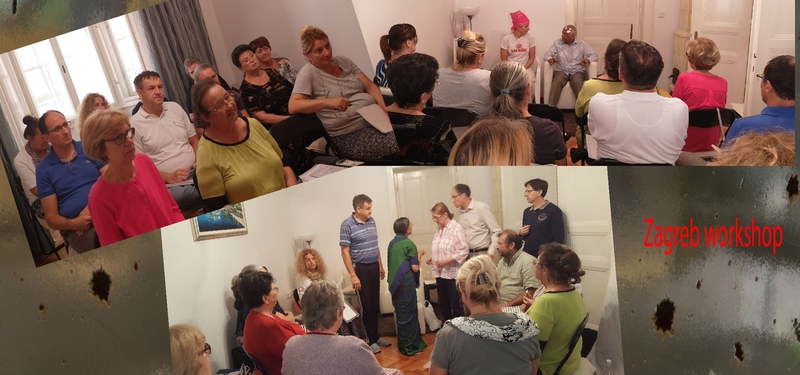
3. Monthly Audio conference, USA, 15 September 2019
Initiated and moderated by North America coordinator and trainer 01339, in this round table discussion on “What is holding us back from having more patients”, participants shared their own novel ideas/practices to reach out to new patients:
- As healed patients are the best spokespeople for vibrionics, don’t hesitate to ask them to refer their family members, friends and coworkers, and their animals and plants.
- A practitioner took 150 Sai Vibrionics trifold brochures and left them out in specific locations at a large Sai gathering. All but a handful were taken. She got 5 new patients so far.
- Two years in a row, two SVPs did an awareness presentation at a community alternative health fair. There were many vendors in attendance. The Vibrionics table was very popular. A colourful cloth-covered table held a laptop with 2 vibrionics videos playing continuously. The trifold brochures with their contact information was on display as was another sign stating the various benefits of vibro treatment and it was free of cost. About 80 brochures were distributed. A lot of people showed interest and asked appropriate questions.
- One SVP has been holding vibrionics information sessions in her home where ‘What is vibrionics?’ video is shown and a talk is given with the 108CC box on display followed by Q & As. Typically 15-20 persons, mostly Sai devotees, would attend; during one session, a guest with psychic ability saw Sai Baba walking around all the people and touching the 108CC bottles. Be very happy and people will want to know more, she has found out. Many take remedies made for them on the spot. Practically all want to know the date of the next such session, so they can tell family and friends.
- Several practitioners find business cards to be very helpful. One SVP includes a few cards with each remedy she gives or mails, for patients to give out. She has had great success in gaining new patients. The group is now looking at standardizing the cards.
- One SVP moved 170 miles to a new city and looked for a way to meet like-minded spiritual people. She recently found such a group that meets twice a week to discuss ‘A Course in Miracles’, a book the practitioner was already familiar with. As a result, she has gained 4 new patients, all by word of mouth from her first patient who experienced the wonderful effects of vibrionics.
- When new patients offer to pay or donate money for the remedies, one SVP tells them the only “payment” she can accept is that they tell others about this healing method. Patients understand this and are happy to tell others and she gets new patients.
- One practitioner takes her remedy in front of people when in public. Strangers or friends will ask her what she’s taking; this gives her a chance to talk about vibrionics.
The group was reminded that the weekly Sunday evening conference call with 108 Gayathri mantra chanting by Sathya Sai for the health and healing of all our patients, present and past, our families and Mother Earth, is a wonderful way to reach out, especially to former patients. They get to know you are thinking of them by inviting them to join the call, so they and their family can benefit from the vibrations of healing love. A side benefit is that some want a refill of their remedy.
4. Annual practitioners’ meet, London, UK 22 September 2019
Organised by the UK coordinator 02822, this seminar was attended by practitioners from all parts of the UK - twenty five (including 3 doctors and 4 nurses) attending in person and 6 through video conferencing. There were 3 members of the host family and one guest speaker, an experienced doctor who has personally benefited from this system and has also referred several of his patients to our practitioners. Two young volunteers took charge of video conferencing, The coordinator had worked very hard inspiring the attendees to send in advance their successful cases to share and also to send their questions and difficult cases for discussion. There was a lot of enthusiasm among those present as they were anxious to get answers to their unusually large number of questions (to appear in future news) and they all enjoyed hearing the successful cases. The general consensus of opinion was that number of patients seeking vibrionics treatment in the UK was going down. So, when presented with the suggestions put forth by the US practitioners (see #3 above), they were very appreciative and decided to put these innovative ideas into practice. Some shared their successful remedies for various problems. SVPs 02899&02900 share an interesting experience of their daughter with vibrionics…
Prevention against Acute Mountain Sickness
This young teacher with a group of 18 children and two colleagues was going for a 4-week geography trip to India. As the trip involved mountain trekking, there was risk of developing Acute Mountain Sickness (AMS) due to high altitude & low oxygen level and sudden weather changes. Therefore the practitioners (her parents) made a prevention remedy directly in alcohol (because otherwise 90 drops would dissolve the pills) in a dropper bottle in which all 108CCs (except from categories 1, 2, 8, 14 & CC17.2 Cleansing) were added. They also gave her as a back-up their normal travel remedy: CC4.4 Constipation + CC4.6 Diarrhoea + CC4.8 Gastroenteritis + CC4.10 Indigestion + CC9.2 Infections acute + CC9.3 Tropical diseases + CC10.1 Emergencies.
On arrival each group member had to purify the drinking water by boiling but the practitioners’ daughter was pleased that all she had to do was to put one drop of the prevention remedy into one litre bottle of water daily and sip this all day long. Her two colleagues teased her for doing this. They started calling her ‘Hippy Dippy’ but she would just laugh. She would have liked to offer these drops to the children but she did not have their parents’ permission.
While the children and her colleagues suffered from symptoms of AMS such as nausea, headache, breathlessness, cough, fever, sleep deprivation, she was the only one who kept healthy throughout the 4-week period. Seeing this, one of her colleagues who was to stay on in India for another month requested her to donate the vibrations to him. After a month, he messaged her saying, ‘Vibrated every day and I have been fine. Proven scientific fact, it works’.

5. SVP workshop, Ales, France, 20-24 Oct 2019
This was held in the home of a recent practitioner who warmly welcomed the participants comprising 4 SVPs and 2 SVP applicants. This highly interactive workshop was experienced as a real deepening of the Sai vibrionics method enriched by discussions on miasms and nosodes, allowing more specific treatment. The new SVPs felt a door opening into another dimension. The participants remarked that working with the 108CC box is simple and somewhat mechanical whereas choosing cards for the potentiser is more analytical and a brain teaser! The attendees had the opportunity to prepare the meals together which allowed them to delve into the principles of healthy eating. Both the new applicants successfully passed their test and received the SRHVP as a precious gift in a very sacred atmosphere, after taking their oath. They were enthusiastic to continue their seva while fully understanding that this new step is giving them even more responsibilities in the vibrionics family, and in the evolution of Sai vibrionics. An octogenarian, longstanding practitioner 02499 transmitted her enthusiasm to all the participants by sharing her years of experience in the use of the potentiser. Dr Aggarwal in his skype call clarified and helped to better understand some of the points the participants had raised, including the reason to give Base chakra before miasms and the use of Bowel nosodes.
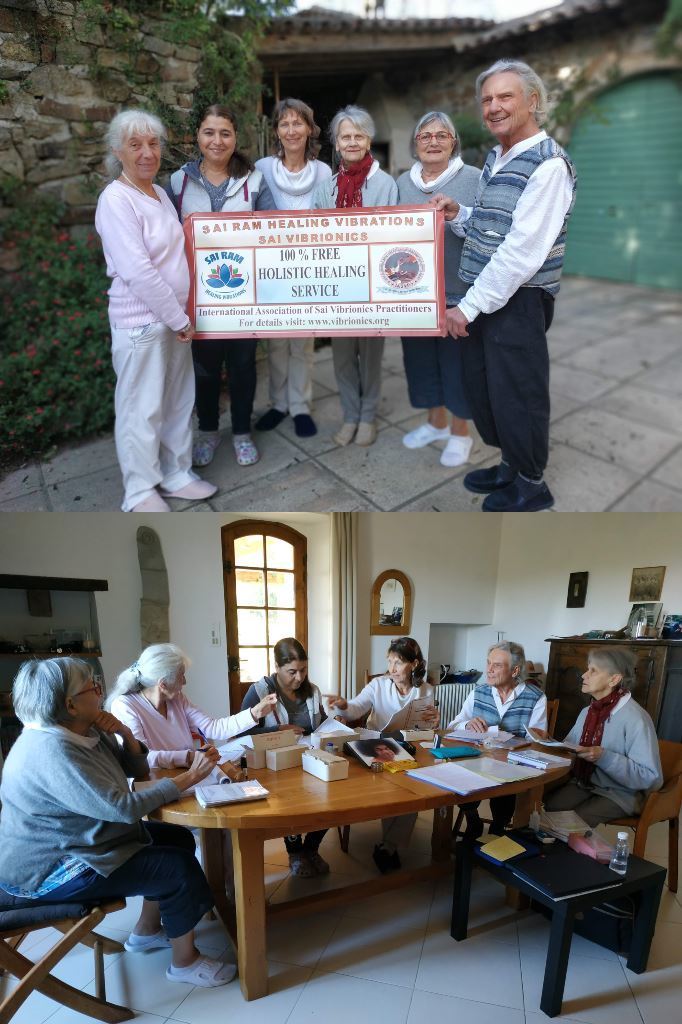
6. AVP workshop and refresher Ales, France, 26-28 October 2019
The AVP workshop and the refresher seminar took place with six participants, among them three SVPs. The participants particularly benefited from the model clinic offered for the first time in a French workshop. Cases for a model clinic had been structured by the SVPs to enable the AVPs to cope with different situations: how to conduct a consultation, which disease to treat first when a patient suffers from two chronic or acute & chronic diseases, how to handle the three types of pullout, how to choose the combos and determine their dosage, and how to taper down dosage after improvement. The AVPs were delighted as the cases and the situations presented really helped them to acquire more knowledge and greater self-confidence for their future practice.
Having been actively involved for several years in vibrionics administrative work for France and after passing the test brilliantly, the newly qualified AVP received the 108CC box with a huge applause. Dr Aggarwal in his skype address further clarified several doubts, including confusion over acute disease and chronic disease with highly acute symptoms.
